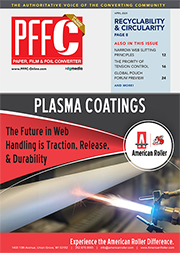Featured Stories
-
Innovation in Extrusion Barriers Can Reduce Brand Owners’ Dependence on Plastic
According to the most recent statistics from the Environmental Protection Agency1, in 2018 the U.S. produced 35 million tons of plastics, while... -
Tension: The First Thing We Must Get Right
Web tension is arguably the most important parameter for any web process. Tension is the first thing we must get right. -
Principles of Narrow Web Slitting
For those veterans in the slitting-winding community, this commentary is not necessarily new information, but reviews are always good too.
News | New Products
-
TIPA Compostable Packaging Appoints John Wilson as Commercial Director for North America
Packaging and sustainability industry veteran joins TIPA, to drive US adoption of compostable packaging to curb plastic waste
-
INX promotes three to Vice President positions
The Board of Directors at INX International Ink Co. have approved the promotions of three key executive managers to vice president positions.
-
Rogelio Barba Villagran Named Business Development Director for AGH Labels North America
AGH Labels, headquartered in Leon, Mexico, is excited to announce long-time executive, Rogelio Barba Villagran, as its business development director for AGH Labels North America.
-
Hong Kong PrintPack Fairs Open in April
Jointly organized by the Hong Kong Trade Development Council and CIEC Exhibition Company (HK) Limited, the two PrintPack Fairs will be April 27-30, 2024 at AsiaWorld-Expo
-
BioEmitter®- Keeping Corrosion and Rust at Bay in Enclosed Spaces
One of the most important missions of Cortec® Corporation, a global leader in the corrosion protection industry, is environmental responsibility.
-
Fedrigoni Names New Commercial Senior Vice President, Chief Marketing Officer
Fedrigoni — the world’s leading manufacturer of specialty papers, premium self-adhesive materials, RFID and connected solutions
-
SEI integrates Vetaphone on new Labelmaster KyoJet
SEI Laser Converting is based in Buja in the northeast corner of Italy.
Expert Advice
Considering China, Part II
- Published: October 01, 2003, By Teresa Koltzenburg, Senior Editor
The second of this two-part series looks at the recent historical context of US manufacturing and surveys recent government efforts to help with the "China Factor."
Click here to read Considering China, Part I (September 2003)
Despite reports of an upswing in the economy, it's as bad as it's ever been. The second part of that sentence is a paraphrased quote that my colleague attributes to a converter with whom she had a friendly phone conversation just before September 11 this year. As she related the story of this experienced converting professional — one who told her he's seeing price squeezes and jobs going overseas like never before — and with the 2001 terrorist-attack second anniversary looming, I couldn't help but think of our now threat-ridden way of life here in the US.
The media purveys the belief (and I would venture to say many American citizens agree) that eventually another terrorist attack will occur on our home soil.
Lately, the mainstream media (likely due to next year's presidential election) has reported almost constantly on currency manipulation, loss of manufacturing jobs, and our growing trade deficit with China — what many believe to be another threat to our way of life.
But it's not like it hasn't been this way before. The Cold War and, during the late 1970s and early 1980s, Japanese manufacturing evoked similar emotions among Americans. We got through those, so we'll get through these, right?
Time Will Tell
Before we try to figure out how our manufacturing sector will compete — in essence survive — it's important to understand how we got to where we are today. According to a senior fellow at the New America Foundation, Dr. David Friedman, who is an attorney, political scientist, economic development specialist, and author, we're where we're at today in terms of manufacturing because of our leaders' penchant for trading manufacturing and its knowledge for political alliances — in essence security — something Americans have a renewed appreciation for since Sept. 11, 2001.
Friedman was the keynote speaker at a Global Business Council (a div. of the Society of the Plastics Industry) Crossroads Forum held this past June at NPE in Chicago. The breakfast meeting, “The China Factor,” featured Friedman and a panel of professionals (manufacturers) from mostly the injection molding part of the plastics sector, as well as representatives from the National Association of Manufacturers and the National Tooling and Manufacturing Association.
But before the panel got down to debate, Friedman imparted to the sold-out audience his perspective on manufacturing, which he reports as having “declined from 25 percent of the nation's economic base, in terms of employment, in 1973, to just about 11 percent (and possibly even lower by some measures) today.”
According to Friedman, “That philosophy, actually, was rampant in the late 1940s, early 1950s.” The prevailing thought during this period, Friedman explains, was “We'll let these countries that we have our eyes on fudge the rules, do whatever they like, because they don't matter all that much. And we're giving them an incentive to become democratic, because trade needs democracy. And we'll give them an incentive to become locked into our Western alliance. And if there's some degree of reversal in the manufacturing area, no problem.”
But the problem with that, he explains, is that in international trade and security relations, “once the blueprint gets imprinted in public policy, it's hard to move [it away]. So as you move into the 1970s and the 1980s, the degree of imports and trade rose significantly. The old habit of linking security to trade never got broken. And in fact, a large number of think tanks, experts, and so forth converged to explain, ‘Well, wait. This is like any reversal [that has occurred].’ Manufacturing declining — that was fine, because manufacturing should decline. So secondary interests rose: ‘Now we can be a service economy,’” says Friedman.
In addition to the effects of global politics on US manufacturing, the sector, overall, says Friedman, also has experienced devaluation in public opinion. “If you look at the total employment at universities and lawyers in the United States today, it amounts to 20 percent of the entire manufacturing workforce. And so what you have is an enormous number of people in the economy in the United States, in the last 30 years, that have no connection whatsoever with the reality of making things.”
So Here We Are
In recent months, there's been a more audible clamor of protests from the general sector itself regarding unfair competition and trade inequities. US manufacturing and its health seem to be more on people's minds. Other recent converting industry publications also have addressed the topic, and trade associations from numerous areas of manufacturing are petitioning the government for trade policy changes.
From the other side, possibly from companies that have benefited from overseas investment, you may have heard comments similar to Friedman's description of what some groups were saying about the “Japan problem” 25 or so years ago: “Shut up already, and figure out how to compete.”
A recent letter from an NPE exhibitor published in the September 1 issue of Crain's Plastics News regarding the “The China Factor” forum echoes such sentiments. The letter, attributed to Nicholas Durante, Profile Molds Inc., Mississauga, ON, Canada, states, in part: “The only strategy that appears to be presented as an action plan is for the government to make changes to policies.”
He then asks: “Whatever happened to rugged individualism and the entrepreneurial spirit that created America? How about being innovative and becoming more efficient? ‘The China Factor’ should be considered an opportunity to the mold-making industry. We have the technology that is perhaps six to eight years ahead. If you follow this ill-fated strategy to march on Washington, change policies, and impose import duties on foreign goods, you might as well bury your collective heads in the sand and wait until the government makes everything right.”
Point Taken
The reality is that government action likely isn't going to be able to counter the losses, although many would like it to continue to try. According to an Associated Press report appearing in an online article on MSNBC September 11, 2003 (msnbc.com/news/965001.asp), “The Bush administration believes the way to deal with rising trade deficits is for other countries to remove trade barriers. That would allow US companies to more freely do business in overseas markets, thus boosting America's global competitiveness, the administration says.”
And despite his visit to China in early September to demand China start allowing market forces to set the value of yuan (also known as the renminbi), Treasury Secretary John Snow couldn't get China to agree to quit pegging its currency (which is about 8.3 to the dollar). In his article, “China agrees to eventually allow its currency to trade freely,” (Sept. 4, 2003, Seattle Post Intelligencer, seattlepi.nwsource.com/business/137927_china04.html), New York Times writer Joseph Kahn reports, “After a two-day visit, Snow left China without a specific timetable for addressing the currency issue.”
So US manufacturing, mostly, may be left to its own devices.
US manufacturing's converting sector seems to be “figuring out how to compete” with the “get lean” concept. More and more, reports of companies employing lean manufacturing, as well as Six Sigma and other quality and efficiency improvement programs, are surfacing. Though, like the government, these types of measures probably won't be able to counter all the losses, they do provide a place to start.
Another less palatable option, albeit likely a necessary one, is the “If you can't beat 'em, join 'em” philosophy, which the big manufacturers already have adopted with investments in plants and office openings in the growing Chinese domestic market and elsewhere in Asia. Costa Mesa, CA-based Interliance LLC (interliance.com) and other offshore consultancy and advisory firms like it provide entry or expansion support into China.
As impressive as it is, China's Great Wall is a lost symbol of protection in our modern, increasingly globally and technologically oriented world. It seems the 21st century is commanding us to construct new ways to learn to live with, and trade with, one another. We have no choice but to learn in order to survive.
This is part two of a two-part series considering China, overseas trade, and manufacturing, and the implications for the North American manufacturing industry. Part one appears in PFFC, September 2003, p114.
PFFC encourages open discussion about this topic in order to accomplish fair coverage of this controversial, increasingly complex issue. Please e-mail feedback to me at This email address is being protected from spambots. You need JavaScript enabled to view it..













